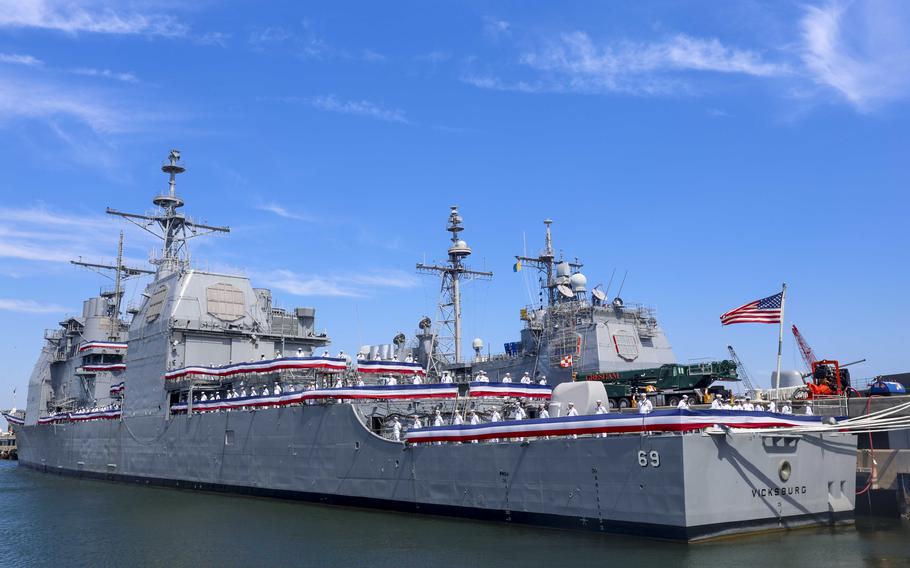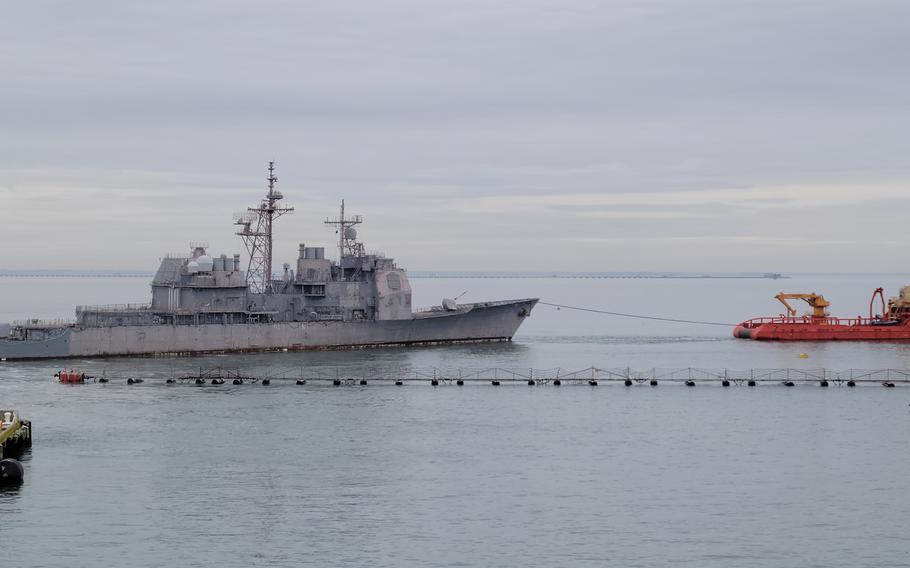
Sailors man the rails during the decommissioning ceremony of the guided-missile cruiser USS Vicksburg (CG 69) in Norfolk, Va., June 28, 2024. The decommissioning ceremony commemorated the history of the ship. (Charles Blaine/U.S. Navy)
WASHINGTON — The Navy wasted nearly $2 billion rehabilitating four aging cruisers that were ultimately decommissioned, according to a scathing report by a federal watchdog.
Since 2015, the Navy has spent about $3.7 billion modernizing seven Ticonderoga class guided-missile cruisers. But only three will be delivered back to fleet, and none will gain five service life years, as intended, the Government Accountability Office said in a report released Tuesday.
“The Navy did not effectively plan the cruiser effort. This led to a high volume of unplanned work — 9,000 contract changes — resulting in cost growth and schedule delays. The Navy has yet to identify the root causes of unplanned work or develop and codify root cause mitigation strategies to prevent poor planning from similarly affecting future surface ship modernization efforts,” the report read.
The modernization plan dates back to 2012, when the Navy proposed retiring several cruisers due to budget constraints. Congress rejected the Navy’s proposal and provided funding to modernize the ships.
In response in 2015, the Navy planned to use a phased approach to modernization that would refit 11 cruisers across a 10-year timeframe in an effort to keep them in the fleet into the 2030s.
In 2017, the plan cut four ships, reducing the modernization effort from 11 ships down to seven.
Four of those seven ships — USS Hue City, USS Anzio, USS Vicksburg and USS Cowpens — ate up $1.84 billion being repaired and modernized, only to never deploy again.
The Navy decommissioned the Hue City and the Anzio in 2022 after spending $161.2 million and $250.54 million, respectively.
The Vicksburg was decommissioned in June after the Navy spent $678.56 million on it, followed by the Cowpens in August, which had $754.1 million in repairs done.

Military Sealift Command’s contracted vessel, one of U.S. flagged Jones Act offshore supply super vessels, Motor Vessel Gary Chouest completed a Dead Ship Tow of the ex-USS Anzio (CG 68) on Dec. 9, 2022. A Dead Ship Tow occurs when a motor vessel like Gary Chouest is able to tow a ship like the ex-USS Anzio, when the ship being towed is greater than 100 gross tons and is no longer able to operate under its own command, nor its own propelling machinery. The three-day tow began on Dec. 6 from Naval Station Norfolk in Virginia and ended on Dec. 9 in Philadelphia, Pa. (LaShawn Sykes/USN Military Sealift Command)
After touring five cruisers and interviewing more than 100 Navy officials, the GAO found that weak oversight, lack of planning and poor-quality work drove the failure of the cruiser modernization program.
“Even though the Navy used more than $2 billion of procurement funding for cruiser modernization, it did not implement planning and oversight tools typical of high dollar major defense acquisition programs following the major capability acquisition pathways because it is not an acquisition program,” the report read.
The Navy’s cruiser modification plan will upgrade three ships — the USS Gettysburg, USS Chosin and USS Cape St. George for the price of $1.9 billion. Originally, all 11 cruisers were meant to complete modernization by 2026.
To date, nearly $599.4 million was spent on the Gettysburg, $695.72 on the Chosin and $601.39 on the Cape St. George. The Chosin and the Gettysburg have successfully completed modernization, with the Gettysburg deploying.
The point of the modernization was to extend cruiser service lives by five years each in an effort to keep more ships in the fleet. While the ships are not currently planned to see 40 years of service life, the sea service will get an extra three years from the ships.
In November the Navy announced in plans to extend service lives of the Gettysburg, Chosin and Cape St. George to 2029, with plans to decommission them in 2030.
The Gettysburg, Chosin and Cape St. George, which were commissioned in 1991, will now see 38 years of service before retirement.
Ultimately, the Navy saw approximately 36% cost growth on the cruisers it attempted to modernize and cumulatively experienced over 15 years of schedule delays.
The GAO recommended the Navy assess root causes of unplanned work by developing mitigation strategies and codifying the strategies in policy and re-assessing its overall approach to quality assurance to prevent similar issues in future surface ship modernization efforts.
“The Navy has other upcoming significant surface ship modernization efforts, such as for 23 destroyers. The success of these efforts is critical to the Navy having a combat-ready fleet,” the report read.
The Navy agreed with the GAO’s recommendations, the report read.